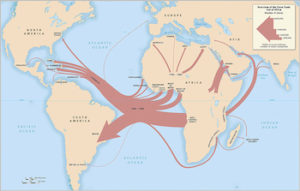
Slave Trade Routes
*On this date in 1440, the Middle Passage is briefly described. The Middle Passage was the stage of the white-organized triangular trade in which millions of Black Africans were kidnapped and transported to the New World.
Sometimes referred to as the Atlantic Slave Trade or transatlantic slave trade, it involved the transportation by slave traders of enslaved African people. Ships departed Europe for African markets with manufactured goods, which were traded for purchased or kidnapped Africans, who were transported across the Atlantic as slaves; the slaves were then sold or traded for raw materials, which would be transported back to Europe to complete the voyage. The First Passage was the transportation of captives (slaves) by the Portuguese in the 15th century. Though beginning in 1441, the Treaty of Tordesillas, Tratado de Tordesilhas, in 1494 made the Middle Passage public and official.
In the 1520s, their first destination of the Middle Passage was Brazil, the closest land west of Africa for Portuguese colonization in the western hemisphere or the “New World”; other Europeans soon followed. Shipowners regarded the slaves as cargo to be transported to the Americas as quickly and cheaply as possible, there to be sold to work on coffee, tobacco, cocoa, sugar, and cotton plantations, gold and silver mines, rice fields, the construction industry, cutting timber for ships, in skilled labor, and as domestic servants. Moving up the coast of what would become South America, white Europeans invaded the Caribbean and Central America. The final Passage was the journey from the disembarkation port to North American ports, such as St. Augustine, Florida; Charleston, South Carolina; New Orleans, Louisiana; and Jamestown, Virginia, where they would be taken to plantations or other destinations to be put to work.
Voyages on the Middle Passage were large financial undertakings, typically organized by companies or groups of investors, rather than individuals. The first Africans kidnapped to the English colonies were classified as indentured servants with a similar legal standing as contract-based workers from Britain and Ireland. One of those companies was the Royal African Company (RAC) from Ireland. Another was the Dutch West India Company based in the Netherlands. By the middle of the 17th century, slavery had hardened into a racial caste, with Black African slaves and their future offspring being legally the property of their owners, as children born to slave mothers were also slaves.
As property, the people were considered merchandise or units of labor and were sold at markets with other goods and services. The major Atlantic slave trading nations, ordered by trade volume, were Portugal, England, France, Spain, the Netherlands, and Denmark. Several had established outposts on the African coast where they purchased slaves from local African leaders. African ports, such as Fort Amsterdam, Elmina, Goree Island, and Bance Island, are where they would be loaded onto ships.
These slaves were managed by a factor established on or near the coast to expedite the shipping of slaves to the New World. Slaves were imprisoned in a factory while awaiting shipment. Other white-European powers, such as Norway (the Danish West Indies Company), Sweden (the Swedish Africa Company), Brandenburg, and traders from South and North America, participated in this business. This was viewed as crucial by Western European monarchies, which, in the late 17th and 18th centuries, were vying with each other to establish overseas empires. The Middle Passage was considered a time of in-betweenness for Black Africans who were forcibly traded from Africa to the Americas.
The ship crew's close quarters and intentional division of established African communities motivated captive Africans to forge bonds of kinship, which then created forced transatlantic communities. Traders (now) in the Americas and the Caribbean received the enslaved Blacks. The enslaved Africans came mostly from eight regions: Senegambia, Upper Guinea, the Windward Coast, Ghana-Gold Coast, the Bight of Benin, the Bight of Biafra, West Central Africa, and Southeastern Africa.
An estimated 15% of Africans died at sea, with mortality rates considerably higher in Africa itself in capturing and transporting Black people to the ships. The conservative estimate of the total number of African deaths at sea directly attributable to the Middle Passage voyage is up to two million. For two hundred years, from 1440 to 1640, Portuguese slavers had a near-monopoly on the export of slaves from Africa. During the 18th century, when the slave trade transported about 6 million Africans, British slavers carried almost 2.5 million more.
Current estimates suggest that approximately 12 million to 12.8 million Africans were forcibly shipped across the Atlantic over 400 years. However, the number purchased by the traders was considerably higher, as the Passage had a high death rate during the voyage. Millions died in seasoning camps in the Caribbean after arriving in the New World. Millions of slaves died due to slave raids, wars, and during transport to western coasts for sale to European slave traders.
The Middle Passage was driven by monetary profit and a moral decline in humanity. Near the beginning of the 19th century, various governments enacted bans on the trade, although illegal smuggling continued to occur. In the early 21st century, several governments formally apologized for the transatlantic slave trade.